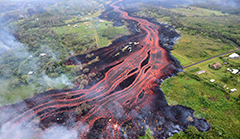Hawaii Island Volcanoes
The fifteen volcanoes that make up the eight principal islands of Hawaii are the youngest in a chain of more than 129 volcanoes that stretch 5,800 kilometres (3,600 mi) across the North Pacific Ocean, called the Hawaiian-Emperor seamount chain. Hawaiʻi's volcanoes rise an average of 4,572 metres (15,000 ft) to reach sea level from their base. The largest, Mauna Loa, is 4,169 metres (13,678 ft) high. As shield volcanoes, they are built by accumulated lava flows, growing a few meters/feet at a time to form a broad and gently sloping shape.
Hawaiian volcanoes all follow a specific pattern of eruption, building, and erosion. Hawaiian islands undergo a systematic pattern of submarine and subaerial growth that is followed by erosion. An island's stage of development reflects its distance from the Hawaii hotspot.
 The island of Hawaii is built from five separate shield volcanoes that erupted somewhat sequentially, one overlapping the other. These volcanoes are: Kīlauea, Mauna Loa, Hualālai, Mauna Kea and Kohala.
The island of Hawaii is built from five separate shield volcanoes that erupted somewhat sequentially, one overlapping the other. These volcanoes are: Kīlauea, Mauna Loa, Hualālai, Mauna Kea and Kohala.
Kīlauea is a currently active shield volcano in the Hawaiian Islands, and the most active of the five volcanoes. It has been erupting nearly continuously since 1983 and has caused considerable property damage, including the destruction of the town of Kalapana in 1990. The 2018 lower Puna eruption, which began May 3, over several weeks opened two dozen lava vents downrift from the summit in Puna. The eruption was accompanied by a strong earthquake on May 4 of Mw 6.9, and nearly 2,000 residents were evacuated from the rural Leilani Estates subdivision and nearby areas. By May 9, 2018, the eruption had destroyed 27 houses, a number that had grown to 75 houses in the lower Puna area by May 31. On May 17, 2018, the volcano explosively erupted at the summit in Halemaumau Crater, throwing ash 30,000 feet into the air. Summit explosions have caused the closure of Hawaii Volcanoes National Park, and vigorous eruptive activity is ongoing in lower Puna,with lava having entered the ocean in three places and destroyed Hawaii's largest freshwater lake. More details
Hawaiian volcanoes all follow a specific pattern of eruption, building, and erosion. Hawaiian islands undergo a systematic pattern of submarine and subaerial growth that is followed by erosion. An island's stage of development reflects its distance from the Hawaii hotspot.
 The island of Hawaii is built from five separate shield volcanoes that erupted somewhat sequentially, one overlapping the other. These volcanoes are: Kīlauea, Mauna Loa, Hualālai, Mauna Kea and Kohala.
The island of Hawaii is built from five separate shield volcanoes that erupted somewhat sequentially, one overlapping the other. These volcanoes are: Kīlauea, Mauna Loa, Hualālai, Mauna Kea and Kohala.Kīlauea is a currently active shield volcano in the Hawaiian Islands, and the most active of the five volcanoes. It has been erupting nearly continuously since 1983 and has caused considerable property damage, including the destruction of the town of Kalapana in 1990. The 2018 lower Puna eruption, which began May 3, over several weeks opened two dozen lava vents downrift from the summit in Puna. The eruption was accompanied by a strong earthquake on May 4 of Mw 6.9, and nearly 2,000 residents were evacuated from the rural Leilani Estates subdivision and nearby areas. By May 9, 2018, the eruption had destroyed 27 houses, a number that had grown to 75 houses in the lower Puna area by May 31. On May 17, 2018, the volcano explosively erupted at the summit in Halemaumau Crater, throwing ash 30,000 feet into the air. Summit explosions have caused the closure of Hawaii Volcanoes National Park, and vigorous eruptive activity is ongoing in lower Puna,with lava having entered the ocean in three places and destroyed Hawaii's largest freshwater lake. More details
